
©2001-2002: Africa Focus
|
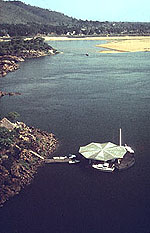
Ubangi River
©2001-2002: Africa Focus
|
|
|
Devided amongst a myriad of ethnic groups, and subjected in the past to raiding slave traders, the Central African Repubic has always been an isolated, under-developed, fragmented and poverty-stricken country, and been plundered for centuries, yet one which, with an enlightened government, could be prosperous. The population is mixed and the different tribes are from diverse ethnic groups. The earliest inhabitants of the country were the pygmies, and some small groups still survive in the forests. Situated in the heart of Africa, the Central African Republic covers a vast area with low population density. The territory is made up mostly of plains, about 500 m above sea level, created by the erosion of ancient mountains. It is bordered on east and west by two high chains of mountains, and on the north by the Chari river and on the south by the Ubangui river. The climate is equatorial and tropical and varies from north to south. To the south the vegetation is virgin equatorial forest, the central region is savannah, and to the north it becomes Sahel, very hot and dry. Chutes des Boali; dramatic waterfall in rainy season, 100 km north-west of Bangui, tumble 50 meters, a meter more than Niagara can manage. Pygmy encampments in M'Baiki are 105 km southwest of Bangui. In Bangui one can find beautiful butterfly-wing art at the Centre Artisanal.
|
Bangui:
|
Bangui is the capital of the Central African Republic. It is situated just west of the Ubangi river. Soapmaking and breweries are common industries in Bangui. There is an oil port here and cotton, timber, coffee and sisal are shipped from the river port. Important buildings and institutions in Bangui include the University of Bangui, which was founded in 1969, the National School of Arts, founded in 1966, research institutes and museums.
Road, railway and river transport connect it with the rest of the country. Also, river and railways connect Bangui with Brazzaville, in Congo. Roads also connect Bangui with Chad and Cameroon, while ferry service connects it to Zongo in DR Congo (Zaire).
|
|
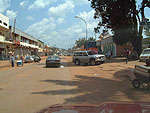
Bangui
©2002: Tourist Office
|
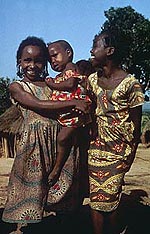
Village Kids
©2002: Africa Focus
|
|
Economy:
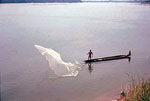
Fisherman
©2001-2002: Africa Focus
|
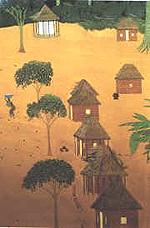
Sibut Tornado
©2002: Tourist Office
|
|
|
Subsistence agriculture and forestry is the backbone of the economy, accounting for about half of GDP, and supporting the two-thirds of CAR's population who live in rural areas. The remaining one third lives in the capital. It has significant amounts mineral deposits. Diamond exports represent close to 60 percent of export earnings and timber represents 16 percent. Although agricultral land covers only 10% of the country, it is rich land and could provide some wealth for the country. However it is used mostly for subsistence farming of manioca and sesame. Cotton and coffee are exported, and precious woods could be exploited. Despite the economic potential afforded by largely unexploited natural resources (diamonds, gold, uranium, and timber), diamonds are the only mineral resource, and the Central African Republic is the 12th producer in the world. There are rich uranium deposits which have not been expolited.
|
History:
French penetration goes back to 1889 when the city of Bangui “the rapid” was founded. In 1905, under the name Ubangui-Chari it became a French colony and part of French Equatorial Africa, where it was defined the “poor relative”. Like other French colonies in Africa it became independent on 13th August 1960, and took the name of Central African Republic. After the death of its most important political leader, Boganda, David Dacko took power and became president. His economic and political leadership was so inefficient that the military, under one of its commanding officers, Bokassa, staged a coup d’etat on 31st December 1965, and Bokassa became president. He soon had himself proclaimed president for life, general secretary of the single party, minister nine times over, and at last emperor. Neither parliament nor the constitution were able to slow him down. The only show of opposition was repressed violently. In foreign affairs Bokassa also fluctuated, managing to come up against the socialist countries, helped by China, as well as against France. In 1979 he was deposed by Dacko, who re-established the Republic. The country had its first multi-party elections in 1993. Ange-Felix Patasse was elected President.
Democracy emerged in CAR at a time of economic crisis (1993) following three years of social and political unrest. Newly-elected President Ange-Félix Patassé formed a coalition government which pledged a commitment to economic and social reform. However, essentially triggered by substantial salary arrears, successive army mutinies with strong ethnic overtones erupted into violent social and political unrest in 1996-97. After military mutinees in 1996, neighbouring states stepped in to help promote peace talks, and a multi-party goverment was formed. A cease-fire brokered by four African heads of state was negotiated in July 1997, and enforced by an inter-African peace keeping force (MISAB) with French support until April 15, 1998, when French financial and military assistance to CAR was reduced and French troops withdrawn. In April 1998, MINURCA, a UN peacekeeping operation was set up to monitor and enforce the cease-fire. MINURCA troops were withdrawn from CAR in March 2000.
Enabling us to improve the quality of the content, if you have additonal information, remarks or suggestions, please share it with us by e-mail.
Last update: 24 April 2008
|